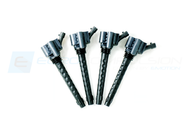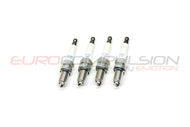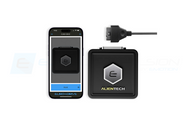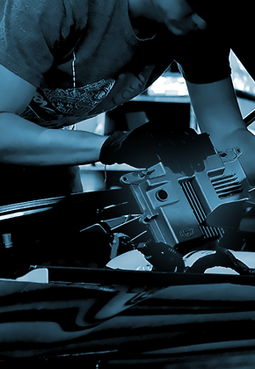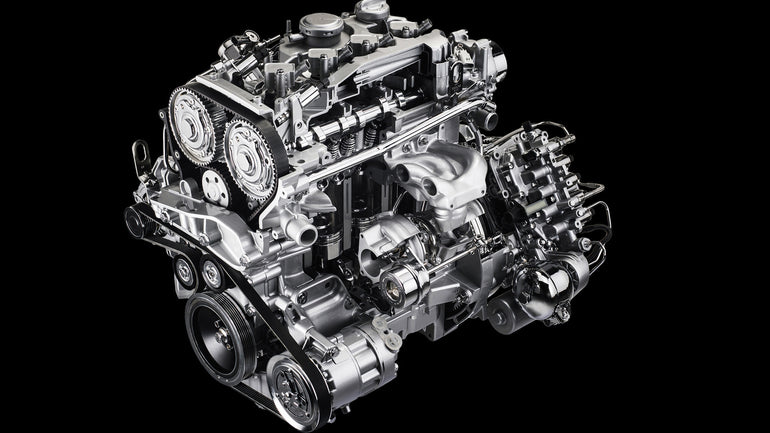
The variable valve timing system or VVT is part of what makes the Alfa Romeo 4C's engine so special. In this article, I plan to explain what it is, what it does for us, and how tuners can take advantage of it.
Alfa came out with VVT long before anyone else. They have used it in production cars sold in the US and worldwide since 1980. They started using electronic controls for the system in the 1985 model year. By comparison, BMW introduced their somewhat equivalent VANOS system in 1992, Ford brought us their system in 1998. The Alfa system in my opinion is still well ahead of both. Honda's VTEC system didn't show up until 1989, and only in the US in 1991. Technically VTEC is completely different from VVT, but it seems that no discussion of valve timing is complete without mentioning VTEC.
History
Let's start with a little History. Alfa introduced the grandfather of the 4C's engine way back in 1954. The basic engine was in production cars until 1994, so it had a very long production run. Along the way it's displacement increased from 1290ccs all the way up to 1962ccs (which they called a 2 liter). They had various updates all throughout the production run, and the engine was competitive with the best engines from Europe and Asia until the early 80's. For purposes of this article we'll call this engine the Nord engine, which is what most people call it. That means North in Italian and it distinguishes it from the Alfa engines that were build in the South in Naples, which were completely different.
The Alfa Romeo Nord Engine:

The old Nord engine had a lot of features that were rare at the time. The basic design is very similar to the 4C engine. Both feature aluminum block and head, double overhead cams, sodium filled valves, and sleeves for the cylinders.
In the late 1970's it became apparent that the old Nord engine would not be able to meet the every increasing US emission standards without seriously sacrificing power. As the Asian and European engines were rapidly gaining on the old Nord engine something had to be done. By this point Alfa was already using every conventional power robbing trick to keep emissions low. They knew that they could get the engine to pass emission if they simply retarded the timing of the intake cam. However that reduced power too much and Alfa enthusiasts had been watching power sadly decline over the last decade and would not have accepted further reductions at that point.
The solution was to employ what we now know as VVT. They ran the intake cam in a retarded position until 1650rpm at which point it was advanced to the “normal” position. Thus it passed emissions, and still ran pretty well. This early VVT system was very simple compared to what we have in the 4C. It only moved one cam, and it only moved it to one of two positions which were 20 degrees apart. It also only moved under one condition, the engine was either at 1650rpm or higher, or it wasn't. The system did not have a lot of control.
Fast forward to the 4C. The new VVT system in the 4C can vary the intake cam an infinite amount within a 60 range, and do it anytime it wants to. The exhaust cam works the same way within a 52 degree range. This has enabled Alfa Romeo and experienced tuners to do some impressive things with this engine, which we will go into soon.
Here is a picture of a Nord Engine with the old VVT system, but now controlled by a modern engine computer.
We have a lot of experience tuning forced induction VVT Alfa Romeo engines. In the case of these older engines, we are still limited to one of two positions, but now we can change the position whenever we want due to the modern ECU.
We were very excited to learn that Alfa would include both a turbo, and VVT on the US spec 4C because, not only do we really like this system, but because we can do a lot with it.
The next engine Alfa came out with after the Nord was the Twin Spark. This engine also featured VVT, and it was a more advanced system than the old Nord, but nothing like what we now have on the 4C. Still, I had to mention it here, because if the Nord engine is the grandfather, than the Twin Spark is the father of the 4C engine.
The Alfa Romeo Twinspark 4 cylinder engine.

The Alfa Romeo 4C's Engine
The 4C's engine displaces 1742ccs. It's often refereed to as a 1750, and some official literature calls it an 1800. For historical, and to an extent taxation reasons Alfa loves displacements of about 1750ccs. This gets confusing because they have had several engines in that range that they have called the “1750” since the 1920's. So if I call the 4C's engine the 1750, it could easily be confused with the Nord 1750 (which was 1779) or one of the Twin Sparks, they had two that were about that size, a 1749 and a 1773.
So what is the official name of the 4C's engine? Get ready, it's The “B TC 1.8 Di Turbo Jet Euro 6” . Uhm... I think I'll just call it the 4C engine.
The VVT system in the 4C engine does a number of things for us. It improves power, improves efficiency, reduces turbo lag, reduces boost threshold, reduces emissions, and eliminates the need for an EGR valve and associated components. It does all of this with an ultra reliable system with relatively few moving parts.
To understand how it does all of this we need to go over some engine and camshaft basics. Many of you already know a lot of this so feel free to skip ahead.
The 4 stroke engine has pistons that go up and down in four distinct strokes. They have names, they are intake, compression, power and exhaust, or in engineering terms suck, squeeze, bang, blow. The intake and exhaust valves must open an close at the right times for these events. For example, the intake valve is open during the intake stroke, both valves are closed during the compression and power strokes, and the exhaust valve is open to let the exhaust out during the exhaust stroke.
The 4 Strokes of a typical piston engine and understanding valve timing numbers

The camshaft controls the opening and closing of the valves. The timing is not a simply as one might think. For example, the intake valve typically opens before the piston reaches the top of the exhaust stroke, and the exhaust valve often closes after the piston has reached the bottom of the power stroke. The exact point when it's optimal to open and close the valves varies with RPM, boost, and other factors, and VVT can optimize these numbers.
Let's talk about real numbers for a moment. Forget about VVT for a moment so we can use the fixed numbers the camshafts are in before the VVT system act upon them.
The 4C engine's valve timing numbers are -24.5/61 31/-12.5 . (note: there are two sets of number published for the 4C's stock cams. This is compounded by the fact that the actual numbers are variable due to the VVT system. I haven't pulled one apart yet to confirm this, but I think the numbers I am using here are the correct numbers for the US spec 4C.
So what do those numbers mean? Well, the first two are for the intake valves, and the second two are for the exhaust. They are given in reference to piston crankshaft and piston position. For example the intake numbers are the points at which the valves open and close in relationship to the pistons Top Dead Center and Bottom Dead Center. Now to add confusion, the first number is always published in terms of before TDC, or BTDC. However notice that the number is negative 24.5. That means that the intake valve opens 24.5 degrees of crankshaft rotation AFTER top dead center. This is unusual, but I'll explain why it does this later. The exhaust valves open 31 degrees before bottom dead center BBDC and closes -12.5 after TDC. Again, the negative number trick means it's actually 12.5 degrees BEFORE TDC.
So in this basic timing configuration, the intake valve opens 24.5 degrees after the piston has started down on it's intake stroke. It doesn't close when the piston reaches the bottom because the intake air still has some momentum and will contine to fill the cylinder for a short time. The intake vale will be closed after 61 degrees bottom dead center.
OVERLAP!
Overlap is defined as the time in degrees of crankshaft rotation that the intake and exhaust valves are open at the same time. In the case of the 4C engine, the base timing (meaning no VVT intervention) does not allow for any overlap. By the time the intake valve opens at 24.5 degrees after TDC, the exhaust valve will have been closed for 37 degrees of crankshaft rotation because it close at 12.5 degrees before TDC. 12.5+24.5=37.
A very common myth in the forced induction world is that overlap on a boosted engine is always bad. That's absolutely false. I have had a section on my website for over 10 years that addresses this myth specifically. This myth usually takes one of two forms. Some people say that boost and fuel will blow out the exhaust valve and be wasted if both valves are open at once. Another camp says that exhaust pressure is too high and that will cause exhaust to back up into the intake. Like most myths, both of these have a shade of truth to them, but when taken in the overall context, they are completely wrong.
Overlap can be used to increase performance, and Alfa's VVT system does that specifically.
Overlap means both intake and exhaust valves are open at the same time.

By changing the cam timing, the VVT system can create overlap. Remember we said that in the base timing scenario there is no overlap because the exhaust valve closes at 12.5 degrees before TDC and the intake doesn't open until 24.5 after TDC. Well, the VVT can advance the intake camshaft timing by as much as 60 degrees. By doing so it can open the intake valve as early as 35.5 degrees BEFORE TDC creating 23 degrees of overlap. In fact it can create overlap by moving either the intake or exhaust cam by itself or it can create a lot of overlap by moving both.
Here is the official VVT chart for the 4C. The solid lines indicate camshaft timing with no VVT intervention. The dashed lines show the maximum possible changes in timing.
So VVT can create, control the amount of, or eliminate overlap, so what? This is a really big deal. The ECU uses three basic overlap strategies.
Strategy 1:
No or very little overlap. There are essentially two condtions that will cause the ECU to run strategy 1. First, at idle and very low rpm this helps prevent exhaust from diluting the intake charge at a point in the rpm range where the engine really can't handle it. This improves idle, emissions, and low rpm performance. It will also use this strategy during certain conditions on boost when max power is being requested. Under certain conditions too much overlap can reduce power because the relatively high exhaust pressure will overcome and push back the air and fuel trying to enter the combustion chamber.
Strategy 2:
Under certain conditions pressure between the piston and the turbine (the hot part of the turbocharger) is higher than the pressure in the intake manifold. Under these conditions the ECU can use Strategy 2 to allow exhaust to recirculate into the intake tract and then back into the combustion chamber. This is an internal EGR (exhaust gas re-circulation) system. It's superior to conventional EGR systems because there are no extra parts to fail, not valves to clog, and it doesn't effect performance because it simply won't implement this strategy at times when you are putting your foot down.
Strategy 3.
There are times when the ECU uses overlap to INCREASE power. When pressure in the intake manifold is greater than the exhaust pressure the intake pressure will help scavenge the exhaust, allow more air in, and at low rpm reduce boost threshold and turbo lag.
There is no crystal clear line where any of these strategies begin and end, they all sort of blur into each other. They are effected by boost, turbine shaft speed, engine rpm, engine temperature, throttle position and more.
You may have noticed that in increase in overlap can either increase or decrease performance. That may seem counter intuitive, but it's true. The effects of overlap vary considerable depending on other variables.
More Cam timing.
The VVT system does a lot more than just control the amount of overlap. In fact it can move either the intake cam, exhaust cam or both quite a bit without creating overlap, and it can move both together maintaining a given amount of overlap but while advancing or retarding both cams.
There are cases where advancing or retarding just one or both cams is advantageous. Fuel economy, power, response, emissions and just about everything is effected by cam timing. The optimal timing for power at high rpm is different than at low rpm and at every point inbetween. The same is true for fuel economy.
In the past, manufacturers had to choose a cam timing configuration that was a compromise. That's no longer the case, with the 4C's VVT system cam timing can be optimal for every driving condition. This is why with base timing the 4C's intake valve opens 24.5 degrees after TDC. Normally you wouldn't have the intake valve open that late, but sometimes it's advantageous and the VVT system is able to take advantage of those situations, hence the extreme 60 degree range of adjustment on the intake cam.
Blatant Commercial:
VVT is both a blessing and a curse for tuners. For us at Eurocompulsion it's a blessing. There is a reason we were able to get over 60 more whp from the 4C engine from our tune with a relatively minor increase in boost. We have been tuning Alfa engines for a long time. While other tuners in the US were removing VVT systems from Nord engines because they didn't understand them, we were exploiting the advantages of VVT on our supercharged Nords. We are bringing our experience and understanding of Alfas to our new product line for the 4C.
Some Pictures of the 4C VVT related components.
Camshaft's and valves. Most of the VVT mechanism is contained within the pulleys and the cams themselves.

This a pretty good look at how the cams and valves are positioned in the cylinder head:
On the actual engine, the cams are buried. The 4C uses the cams to drive various accessories.


